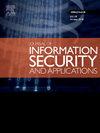A lightweight intrusion detection system for connected autonomous vehicles based on ECANet and image encoding
IF 3.8
2区 计算机科学
Q2 COMPUTER SCIENCE, INFORMATION SYSTEMS
Journal of Information Security and Applications
Pub Date : 2025-05-17
DOI:10.1016/j.jisa.2025.104082
引用次数: 0
Abstract
The Controller Area Network (CAN) bus plays an essential role in Connected Autonomous Vehicles (CAVs), yet its inherent design limitations regarding data protection make it susceptible to malicious intrusions. Contemporary research in intrusion detection predominantly employs Long Short-Term Memory (LSTM) models to analyze CAN IDs as time series data. However, the high computational complexity of LSTM models makes them unsuitable for resource constrained in-vehicle network. To address this problem, a lightweight IDS combining image encoding and an Efficient Channel Attention (ECA) network is proposed. Specifically, three temporal image encoding techniques, Gramian Angular Sum Fields, Markov Transition Fields, and Recurrence Plots are employed to transform CAN ID time-series data into single-channel images, which are then superimposed into three-channel images. A lightweight three-layer convolutional neural network integrated with an ECA module dynamically adjusts channel weights for image classification. Evaluated on real in-vehicle datasets, the method achieves classification accuracies of 99.83%, 99.98%, and 98.75% across three test scenarios with 5.5ms average inference time, demonstrating robust detection capability and computational efficiency.
一种基于ECANet和图像编码的轻型联网自动驾驶汽车入侵检测系统
控制器区域网络(CAN)总线在联网自动驾驶汽车(cav)中发挥着至关重要的作用,但其在数据保护方面的固有设计限制使其容易受到恶意入侵。当前入侵检测研究主要采用长短期记忆(LSTM)模型将CAN id作为时间序列数据进行分析。然而,LSTM模型的高计算复杂度使其不适用于资源受限的车载网络。为了解决这一问题,提出了一种结合图像编码和高效通道注意(ECA)网络的轻量级IDS。具体而言,采用三种时间图像编码技术,即格拉曼角和场、马尔可夫过渡场和递归图,将CAN ID时间序列数据转换为单通道图像,然后将其叠加为三通道图像。一个轻量级的三层卷积神经网络集成了一个ECA模块动态调整通道权重的图像分类。在真实的车载数据集上,该方法在三个测试场景下的分类准确率分别为99.83%、99.98%和98.75%,平均推理时间为5.5ms,显示出强大的检测能力和计算效率。
本文章由计算机程序翻译,如有差异,请以英文原文为准。
求助全文
约1分钟内获得全文
求助全文
来源期刊

Journal of Information Security and Applications
Computer Science-Computer Networks and Communications
CiteScore
10.90
自引率
5.40%
发文量
206
审稿时长
56 days
期刊介绍:
Journal of Information Security and Applications (JISA) focuses on the original research and practice-driven applications with relevance to information security and applications. JISA provides a common linkage between a vibrant scientific and research community and industry professionals by offering a clear view on modern problems and challenges in information security, as well as identifying promising scientific and "best-practice" solutions. JISA issues offer a balance between original research work and innovative industrial approaches by internationally renowned information security experts and researchers.
 求助内容:
求助内容: 应助结果提醒方式:
应助结果提醒方式:


